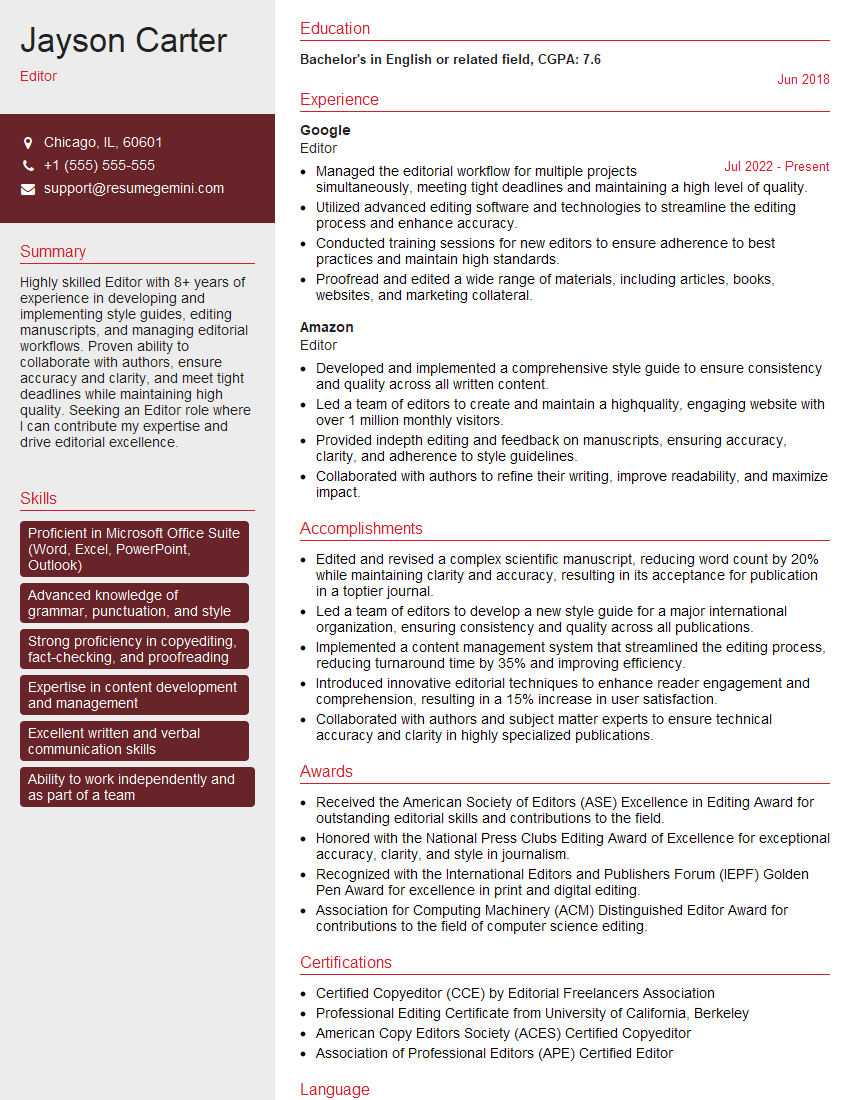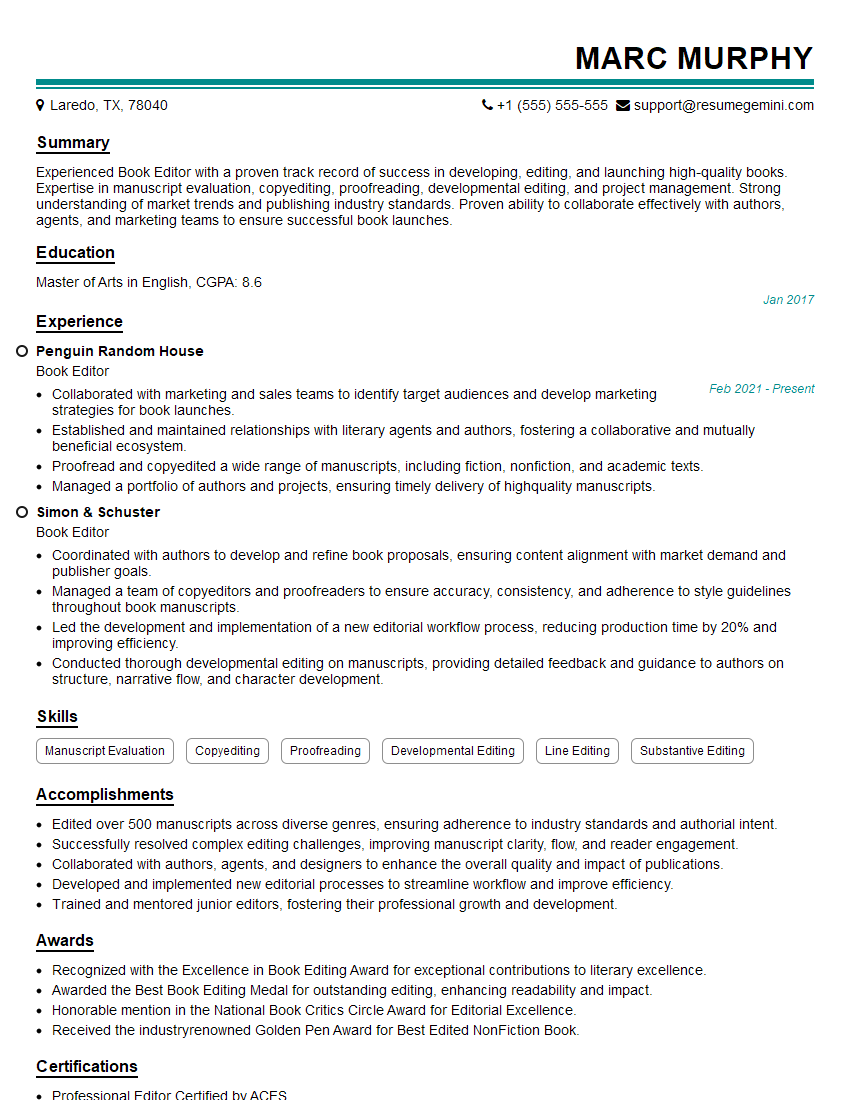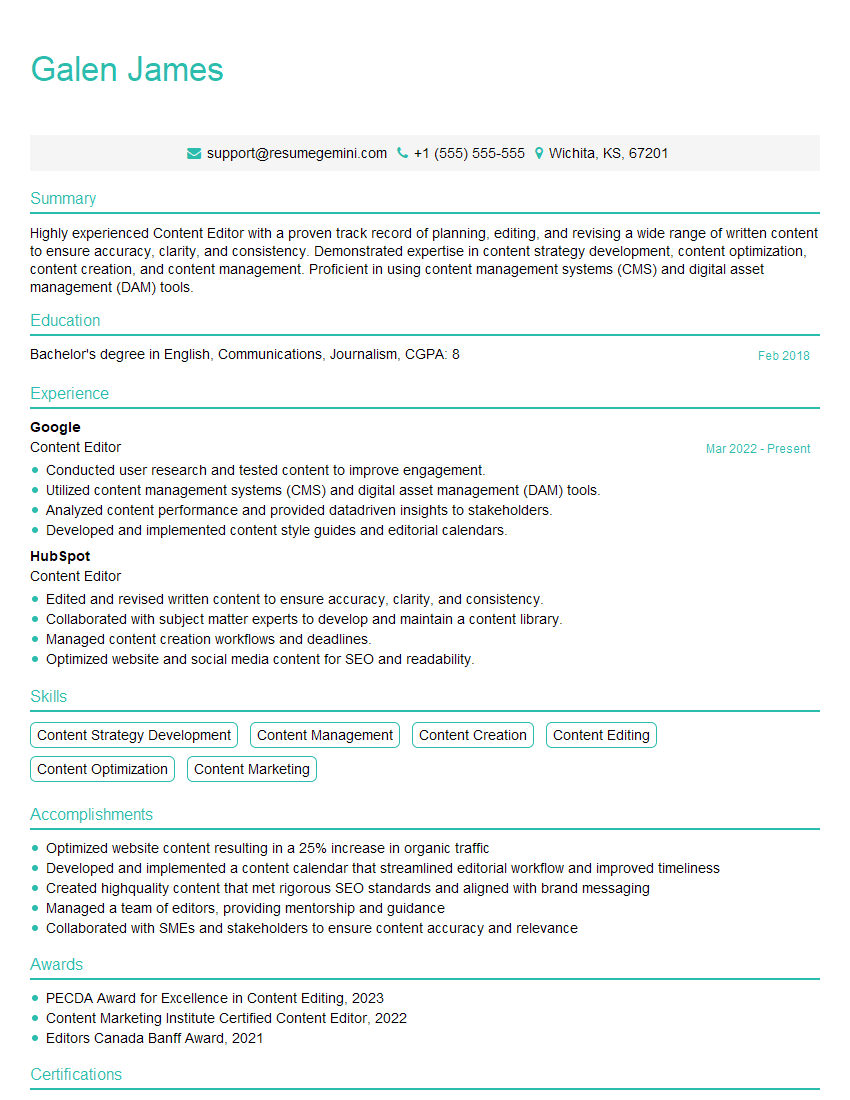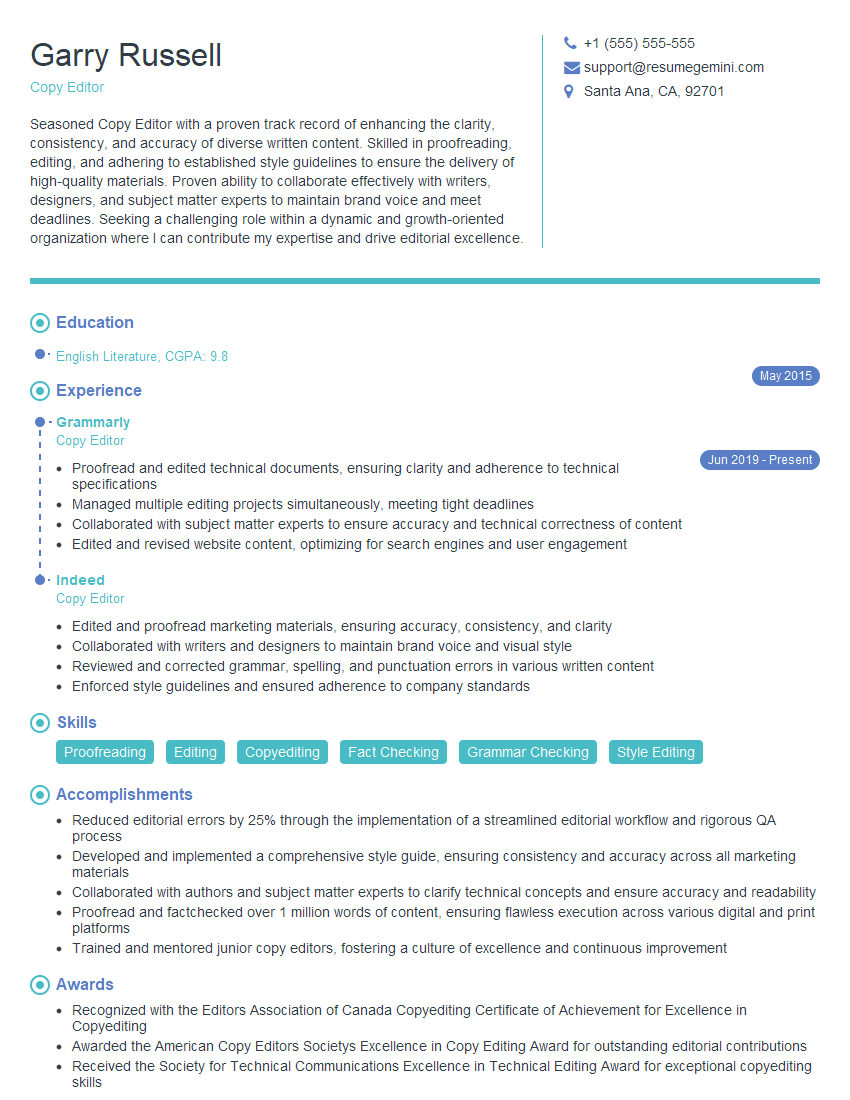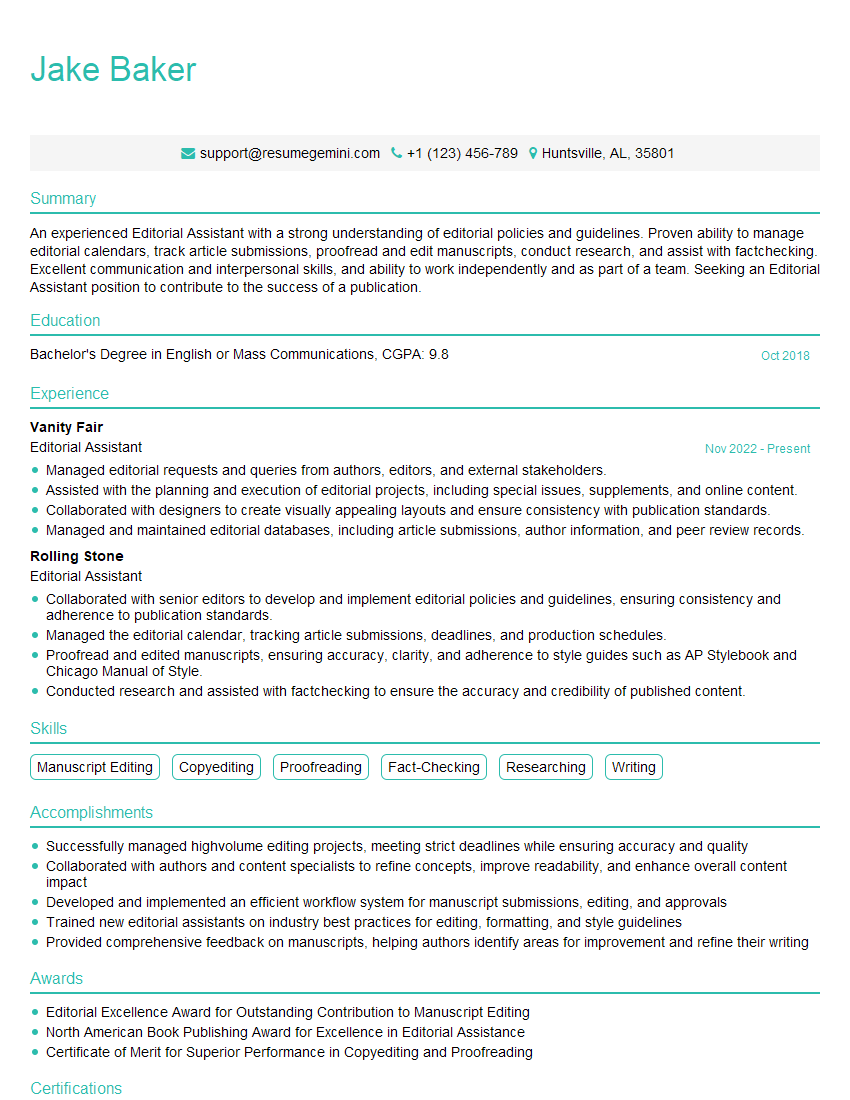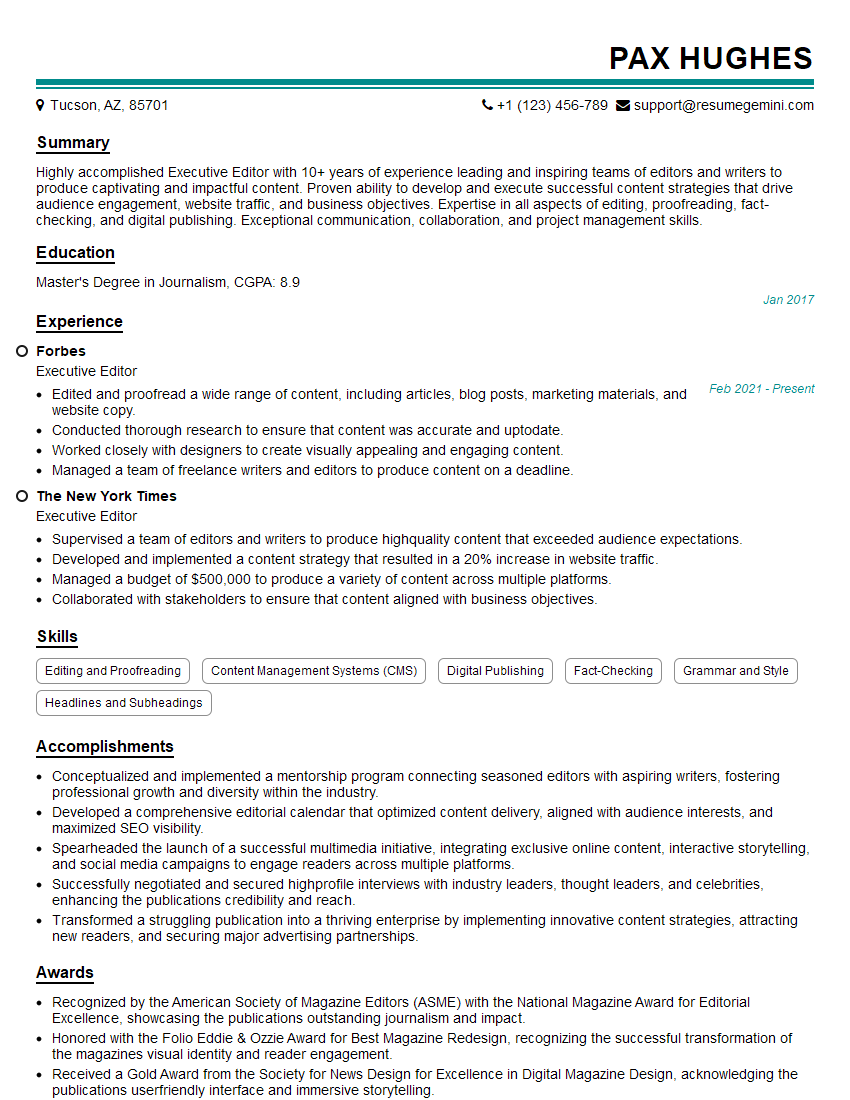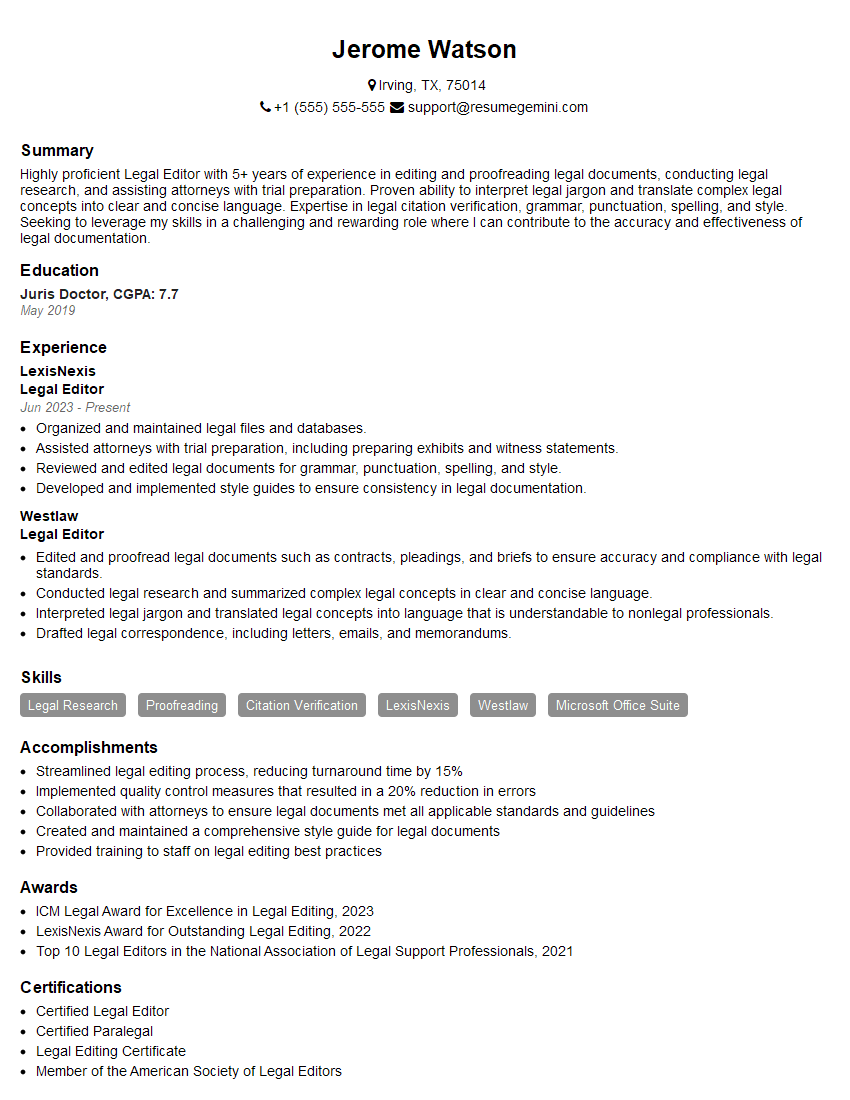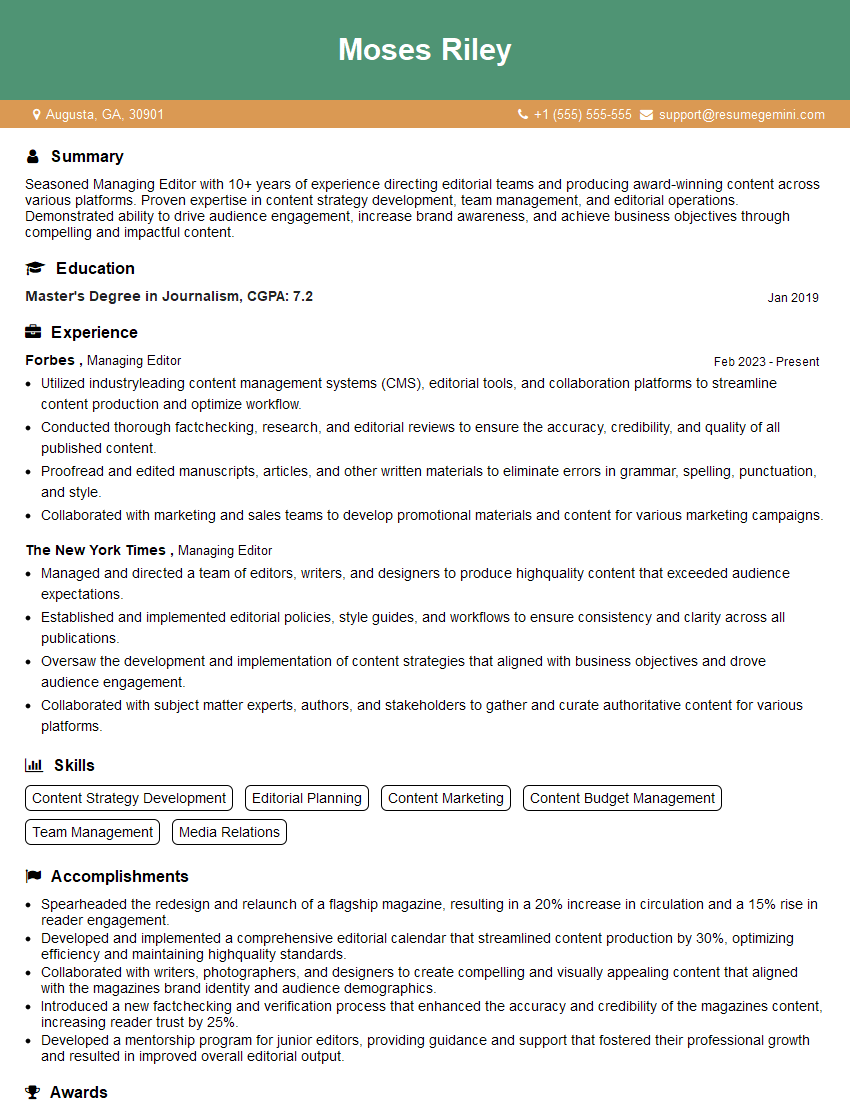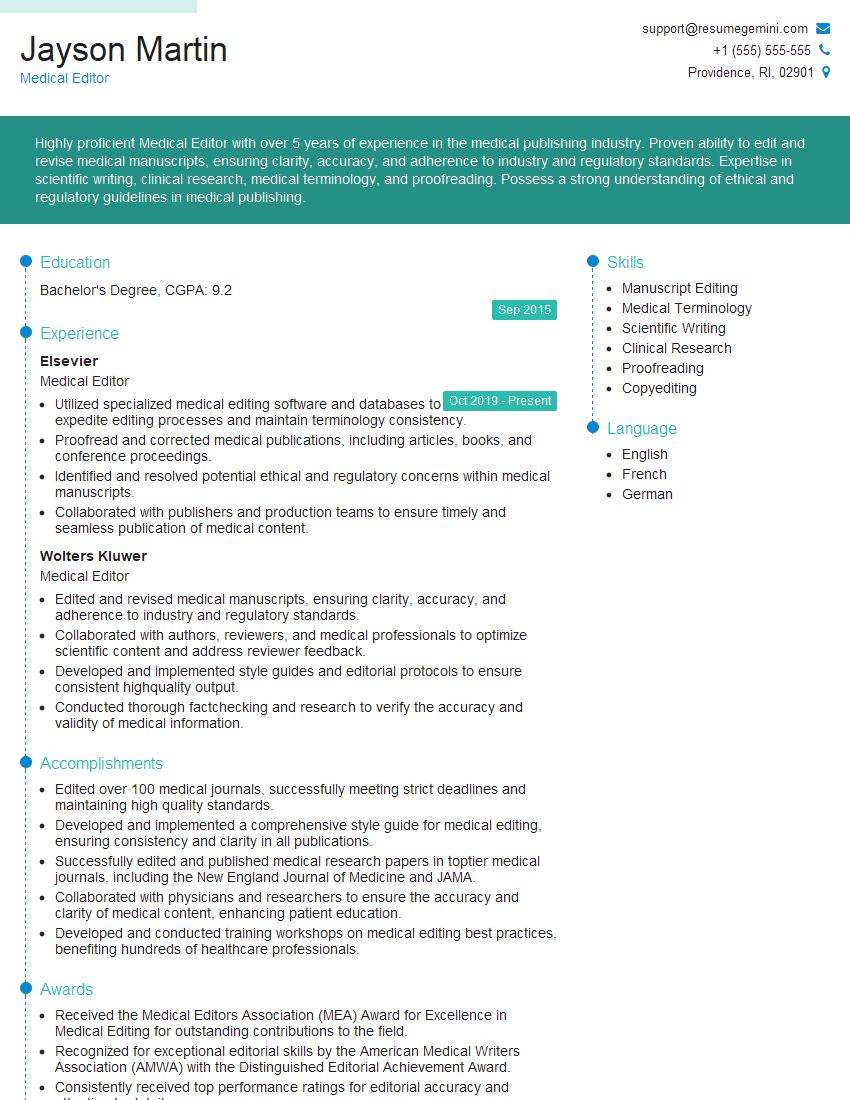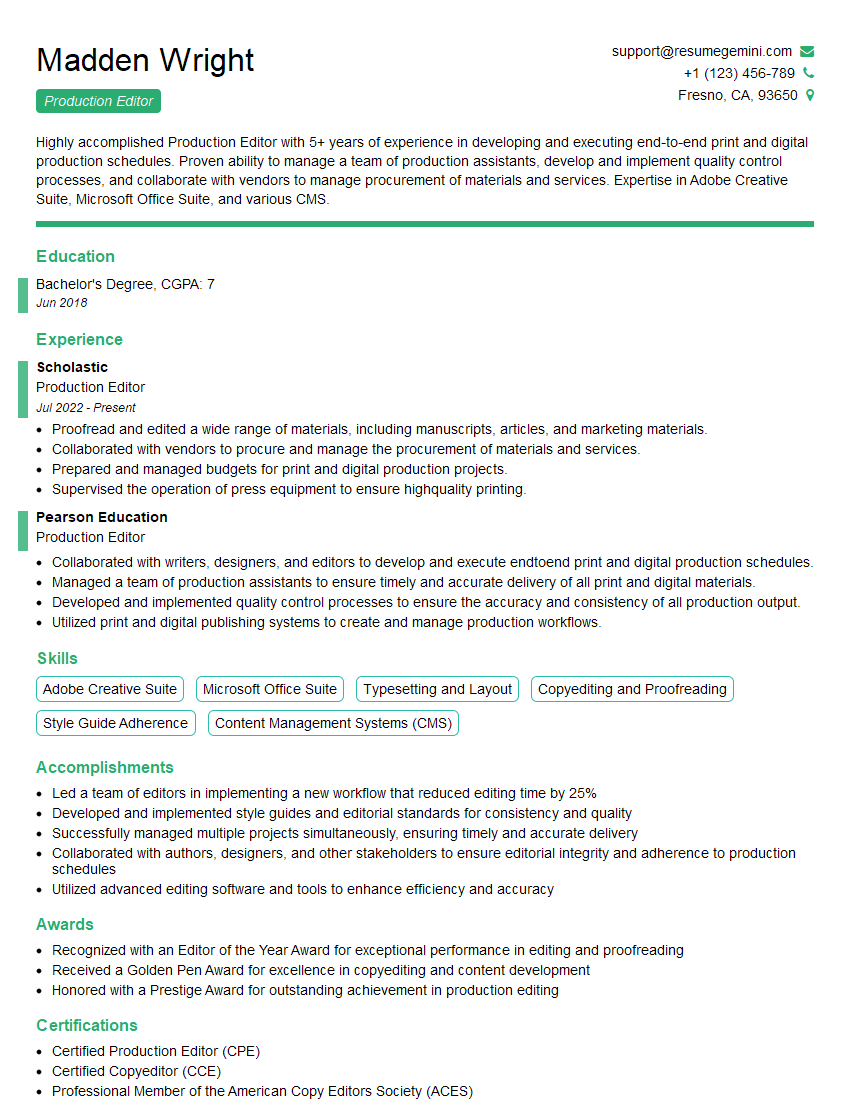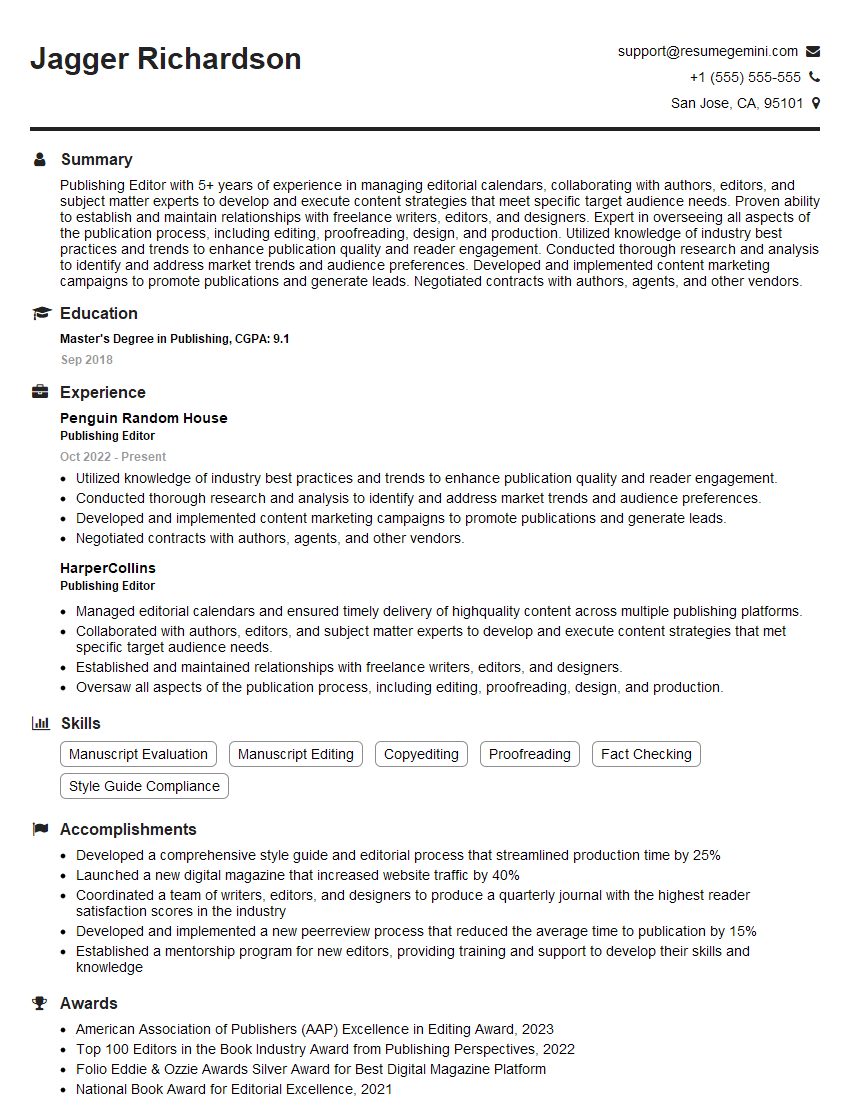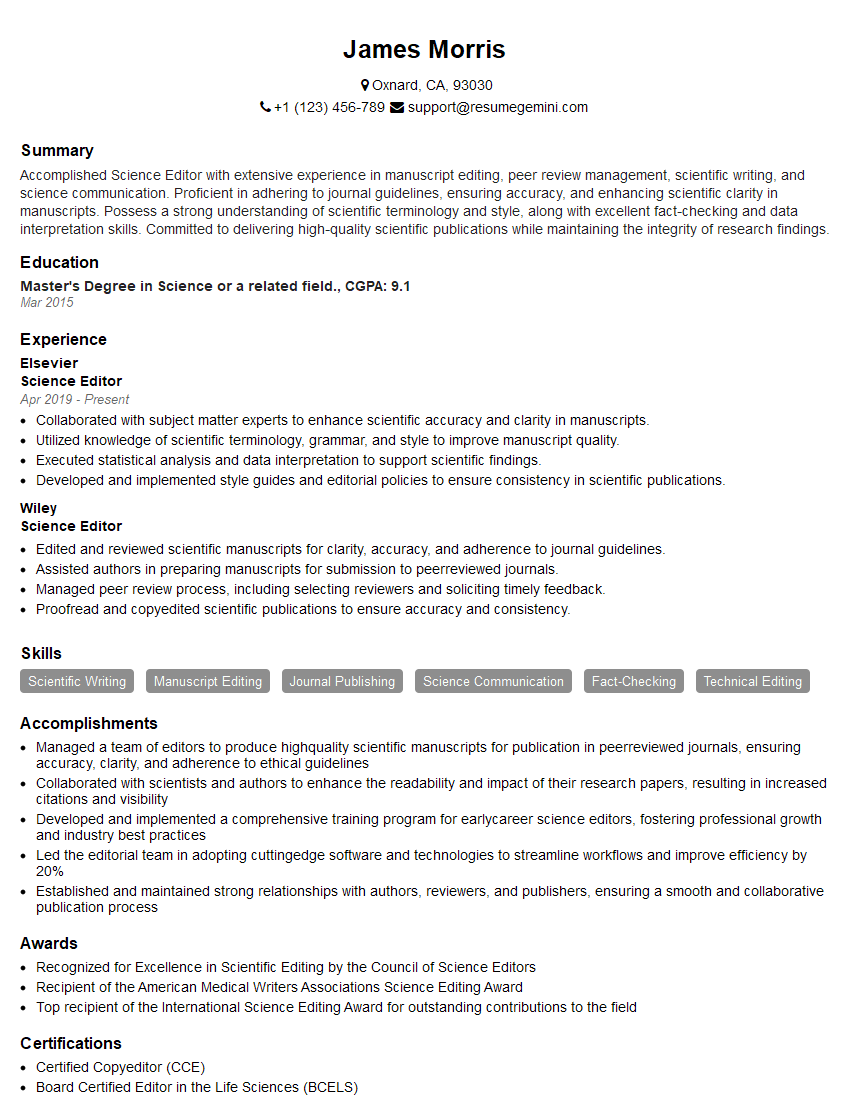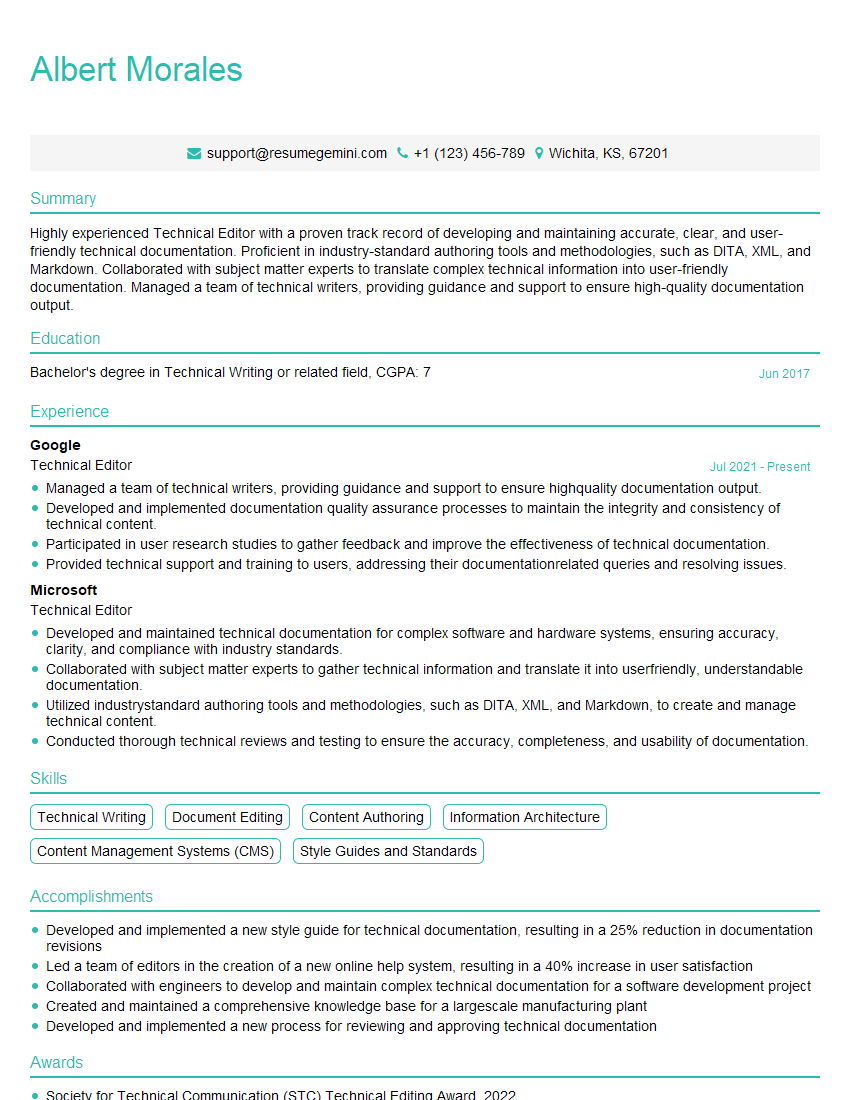The right preparation can turn an interview into an opportunity to showcase your expertise. This guide to Editing and Proofreading Skills interview questions is your ultimate resource, providing key insights and tips to help you ace your responses and stand out as a top candidate.
Questions Asked in Editing and Proofreading Skills Interview
Q 1. What is the difference between editing and proofreading?
Editing and proofreading are both crucial stages in the writing process, but they focus on different aspects. Think of editing as the ‘big picture’ and proofreading as the ‘fine details’.
Editing is a comprehensive process that involves improving the overall clarity, organization, style, and content of a written piece. This includes restructuring paragraphs, refining sentences, ensuring logical flow, and checking for consistency in tone and style. It’s about making the writing the best it can be.
Proofreading, on the other hand, is the final stage, concentrating solely on surface errors like typos, grammatical mistakes, punctuation errors, and inconsistencies in formatting. It’s a meticulous check for minor errors that could detract from the overall professionalism of the document.
Example: Imagine you’ve written an essay. Editing would involve checking the argument’s logic, improving sentence structure, and ensuring the essay flows smoothly from one point to the next. Proofreading would then involve checking for spelling errors, missing commas, and ensuring consistent capitalization throughout.
Q 2. Describe your experience with style guides (e.g., AP, Chicago).
I’m proficient in several style guides, most notably the AP (Associated Press) and Chicago styles. My experience encompasses adapting my editing to the specific requirements of each guide, ensuring consistency and accuracy in every project.
For example, I’ve worked on numerous journalistic articles adhering strictly to AP style, paying close attention to details like date formats, number styles, and capitalization rules. On other projects, I’ve utilized the Chicago Manual of Style, which often involves more flexibility in formatting but requires a rigorous understanding of citation and bibliographic conventions. I regularly consult style guides throughout the editing process, ensuring accuracy and consistency. I’ve also worked on projects with customized style guides specific to the client or publication, demonstrating my adaptability to diverse requirements.
Q 3. How do you handle conflicting deadlines?
Conflicting deadlines are a reality in editing. My approach involves prioritizing tasks based on urgency and impact. I use project management techniques like creating detailed timelines, breaking down large projects into smaller, manageable tasks, and communicating proactively with clients to manage expectations.
For instance, if I have two pressing deadlines, I’ll assess which project has a more immediate consequence for the client and allocate my time accordingly. Open communication with the client is key; sometimes, a minor adjustment in deadlines is possible through collaborative discussion.
I also utilize time management tools, like task management software and detailed to-do lists, to stay on track and allocate my time efficiently, ensuring that even under pressure I can deliver high-quality work.
Q 4. Explain your process for editing a complex technical document.
Editing a complex technical document requires a methodical approach. My process typically involves:
- Initial Review: I first read the document for overall comprehension, identifying the target audience and the document’s purpose.
- Structural Editing: I then focus on the organization, ensuring logical flow and clarity of information. This may involve reorganizing sections, adding headings and subheadings, and improving transitions.
- Content Editing: At this stage, I scrutinize the content itself, refining sentences, ensuring accuracy of technical information, and eliminating jargon where appropriate. I may consult additional resources to ensure factual accuracy.
- Style and Tone Editing: I ensure consistency in style, tone, and voice throughout. I adhere to any specified style guide and maintain a consistent level of formality.
- Proofreading: Finally, I conduct a thorough proofread, looking for typos, grammatical errors, punctuation issues, and formatting inconsistencies.
Throughout this process, I maintain detailed notes and revisions, ensuring a transparent and easily trackable workflow. I always aim to provide constructive feedback and work closely with the author or client to ensure a final product that meets the highest standards of clarity, accuracy, and professionalism.
Q 5. How familiar are you with grammar and punctuation rules?
My familiarity with grammar and punctuation rules is comprehensive and deeply ingrained. I have a strong foundation in English grammar and punctuation, and I regularly stay updated on contemporary usage. I’m adept at identifying and correcting errors related to subject-verb agreement, pronoun case, tense consistency, comma splices, misplaced modifiers, and other grammatical intricacies.
I consider grammar and punctuation as integral to clear communication and maintain meticulous attention to detail to ensure accuracy and consistency in every document I handle.
Q 6. How do you ensure consistency in style and tone across a document?
Consistency in style and tone is crucial for creating a professional and polished document. My approach involves:
- Style Guide Adherence: I strictly adhere to any provided style guide (AP, Chicago, etc.) throughout the entire document.
- Creating a Style Sheet: For projects without a pre-existing guide, I often create a personalized style sheet outlining specific formatting and style choices to ensure uniformity.
- Consistent Terminology: I use the same terms and definitions consistently throughout. If there’s ambiguity, I define and utilize the chosen terminology consistently.
- Multiple Readings: I read the document multiple times, paying close attention to consistency in formatting, tone, voice, and word choice.
- Using Tools: Software tools can assist with consistency checks by highlighting potential variations in style or formatting.
By employing this multi-pronged approach, I eliminate discrepancies and ensure the document maintains a professional, cohesive voice.
Q 7. Describe your approach to fact-checking.
Fact-checking is a critical component of my editing process, particularly for documents requiring high levels of accuracy such as research papers, news articles, and technical reports. My approach is systematic and multi-layered:
- Identifying Claims: I begin by identifying all factual claims and assertions within the document.
- Source Verification: I verify each claim against reliable and credible sources. This may involve consulting primary sources, academic databases, reputable websites, or other trusted references.
- Multiple Source Cross-Reference: I strive to cross-reference information from multiple sources to validate accuracy and ensure consistency.
- Citation Accuracy: I carefully check the accuracy and consistency of citations and ensure they are formatted correctly according to the relevant style guide.
- Documentation: I meticulously document all sources and any discrepancies encountered during the fact-checking process.
Fact-checking is a time-intensive process, but accuracy is paramount; thoroughness is crucial for maintaining the integrity and credibility of the document.
Q 8. How do you identify and correct grammatical errors?
Identifying and correcting grammatical errors is a multi-step process that requires a keen eye for detail and a strong understanding of grammar rules. I begin by reading the text carefully, focusing on sentence structure, verb tense consistency, subject-verb agreement, pronoun usage, and punctuation.
For instance, I might encounter a sentence like: "The dog, along with its owners, were walking in the park." This contains a subject-verb agreement error. The subject is singular (“dog”), but the verb is plural (“were”). The correct sentence would be: "The dog, along with its owners, was walking in the park."
I use a combination of techniques including:
- Proofreading tools: While I don’t rely solely on them, tools like Grammarly can help identify potential errors. However, I always double-check their suggestions.
- Reading aloud: Hearing the text allows me to catch awkward phrasing and grammatical inconsistencies that might be missed when reading silently.
- Understanding grammatical principles: A solid foundation in grammar allows me to pinpoint the exact issue and apply the correct solution efficiently.
Beyond simple errors, I carefully analyze sentence structure to ensure clarity and conciseness. I look for instances of dangling modifiers, comma splices, and run-on sentences, correcting them using appropriate punctuation and sentence restructuring techniques.
Q 9. How do you use track changes effectively?
Track Changes is an invaluable tool for collaborative editing. I use it extensively to ensure clear communication and easy revision tracking. Before I begin, I make sure the author and I are both familiar with the Track Changes functionality and the different revision marks (insertions, deletions, comments).
My workflow involves accepting or rejecting changes one by one, adding comments to explain my edits whenever necessary. This avoids misunderstandings and fosters clear dialogue. For larger projects, I might color-code my edits (e.g., grammatical errors in red, style edits in blue) to help the author quickly understand the nature of each change. For example, I might use a comment like: “Consider rephrasing for clarity” alongside a suggested edit.
I also leverage the ‘Show Markup’ and ‘Accept/Reject’ options within the Track Changes feature. I prefer a systematic approach, reviewing edits section by section rather than jumping around. Once revisions are complete, I can easily review the changes made and ensure the document’s accuracy before finalizing.
Q 10. What are some common errors you encounter in editing?
The most common errors I encounter are:
- Subject-verb agreement: Incorrect verb forms used with singular or plural subjects.
- Pronoun agreement: Mismatched pronouns and antecedents (the noun the pronoun refers to).
- Comma splices and run-on sentences: Incorrect use of commas to join independent clauses.
- Incorrect tense: Inconsistent verb tenses throughout the text.
- Dangling modifiers: Phrases or clauses that don’t clearly modify the intended word.
- Style and tone inconsistencies: Shifts in tone or voice that disrupt the flow and consistency of the text.
- Typos and spelling errors: Simple mistakes often overlooked in the writing process.
- Passive voice overuse: Excessive use of passive voice can make writing sound weaker and less direct.
These errors, while seemingly minor, can significantly impact clarity, readability, and the overall impact of the text. I pay particular attention to ensuring logical flow and grammatical accuracy across the entire manuscript.
Q 11. How do you handle feedback from authors or clients?
Handling feedback is crucial for effective collaboration. My approach involves actively listening to the author’s or client’s concerns, asking clarifying questions if anything is unclear. I always maintain a professional and respectful tone, even when disagreeing with suggestions. I try to understand the rationale behind the feedback, even if I ultimately decide not to implement a specific change.
I document all feedback and my responses, clearly outlining the reasons for accepting or rejecting suggestions. I often provide alternative solutions or explanations, focusing on improving the text while maintaining the author’s intended message. For example, I might say, “While I understand your preference, using passive voice here weakens the sentence. Here’s an alternative using active voice that I think achieves your goals better.”
I believe that a strong communication strategy is essential. Clear and concise communication, combined with a willingness to explain my edits thoroughly, enhances collaboration and results in a polished final product.
Q 12. How do you prioritize tasks when working on multiple projects?
When juggling multiple projects, I prioritize tasks using a system that combines urgency and importance. I typically employ a Kanban board or a similar project management tool to visualize my workflow. I assess each project based on its deadline, the client’s expectations, and the complexity of the work.
My approach involves breaking down larger projects into smaller, manageable tasks, assigning deadlines to each. This allows for better time management and prevents feeling overwhelmed. I regularly review my schedule, adjusting priorities as needed based on changing deadlines or unexpected requests. I also allocate specific time blocks for certain tasks to avoid context switching and maintain focus.
Effective communication with clients regarding potential delays or adjustments to deadlines is also crucial for maintaining transparency and building trust.
Q 13. Describe your experience with different types of editing (developmental, line, copy).
I have extensive experience in all three types of editing: developmental, line, and copy.
- Developmental editing focuses on the big picture – the structure, organization, and overall narrative of a piece. In this stage, I might help an author refine their plot, develop characters more fully, or ensure a logical flow of ideas. I often work with authors during the early stages of manuscript development to provide high-level feedback and suggestions.
- Line editing focuses on sentence-level improvements—clarity, style, tone, and consistency. This is where I polish the text for grammar, mechanics, and style, ensuring it flows smoothly and is easy to read. Line editing often takes place after the developmental editing stage.
- Copy editing is the most detailed level, where I check for grammar, spelling, punctuation, and consistency. It ensures the text is error-free and conforms to the style guide (e.g., AP, Chicago). I focus on ensuring accuracy and consistency in style, tone, and fact-checking.
Each level builds upon the previous one, creating a polished and effective final product. Understanding the nuances of each type allows me to tailor my editing approach to the specific needs of the project.
Q 14. What software are you proficient in (e.g., MS Word, InDesign)?
I am proficient in a range of software applications commonly used in editing and publishing. My expertise includes:
- Microsoft Word: I’m highly skilled in using all its features, including Track Changes, Styles, and advanced formatting options.
- Adobe InDesign: I have extensive experience working with InDesign for layout, design, and formatting of documents, particularly longer works or those requiring complex page layouts.
- Adobe Acrobat Pro: I utilize Acrobat Pro for PDF editing, commenting, and creating accessible PDFs.
Beyond these, I’m comfortable using other tools such as Google Docs and various style guide checkers. I’m always keen to learn and adapt to new software and technologies to enhance my efficiency and skills.
Q 15. How do you maintain accuracy and attention to detail?
Maintaining accuracy and attention to detail in editing is paramount. It’s not just about catching typos; it’s about ensuring the text is factually correct, consistent in style, and free from errors of any kind. My approach is multi-pronged.
- Multiple Reads: I employ a multi-stage editing process. A first read focuses on the big picture – flow, argument, and overall structure. Subsequent reads zoom in on sentence-level issues, grammar, punctuation, and fact-checking.
- Reference Materials: I always have style guides (like the Chicago Manual of Style or AP Stylebook), dictionaries, and thesauruses readily available. I use these to verify facts, confirm spellings, and ensure consistent terminology.
- Checklists and Templates: I use checklists to systematically track my progress and ensure I haven’t missed anything. These checklists can be customized for different types of documents or clients’ specific needs.
- Proofreading Techniques: I employ various proofreading techniques, such as reading aloud to catch awkward phrasing or reading backwards to focus on individual words rather than the overall meaning.
- Fresh Eyes: After a break, I always review my own edits with fresh eyes. This allows me to spot errors I might have missed during the initial editing process. Sometimes, having a colleague review my work provides an additional layer of quality control.
For example, when editing a scientific paper, I meticulously check all data points, citations, and figures to ensure accuracy and consistency with the established methodology. In fiction editing, I verify consistency in character details and plot points across the entire manuscript. This meticulous approach allows me to deliver highly accurate and polished work.
Career Expert Tips:
- Ace those interviews! Prepare effectively by reviewing the Top 50 Most Common Interview Questions on ResumeGemini.
- Navigate your job search with confidence! Explore a wide range of Career Tips on ResumeGemini. Learn about common challenges and recommendations to overcome them.
- Craft the perfect resume! Master the Art of Resume Writing with ResumeGemini’s guide. Showcase your unique qualifications and achievements effectively.
- Don’t miss out on holiday savings! Build your dream resume with ResumeGemini’s ATS optimized templates.
Q 16. Explain your method for identifying plagiarism.
Identifying plagiarism is crucial for maintaining academic and professional integrity. My process involves several steps.
- Software Tools: I utilize plagiarism detection software like Turnitin or Grammarly to perform initial scans. These tools highlight sections of text that match existing sources.
- Manual Review: I always conduct a thorough manual review of the flagged sections. Software isn’t perfect and may flag legitimate citations or coincidental similarities. I examine the context, phrasing, and overall argument to determine if plagiarism is intentional or accidental.
- Source Verification: If a similarity is identified, I verify the source using multiple resources. This helps determine if the similarity is a legitimate quotation (with proper attribution), a paraphrased idea (with proper citation), or actual plagiarism.
- Citation Style Checking: I check for the consistent and correct use of citation styles (MLA, APA, Chicago, etc.). Inconsistent or absent citations are red flags.
I remember once catching a student who had copied large portions of a research paper from a website, changing only a few words. The plagiarism detection software highlighted the problem, but my manual review allowed me to pinpoint the precise source and the extent of the plagiarism. Presenting my findings clearly to the student and their instructor allowed for appropriate action.
Q 17. How do you handle ambiguity in a text?
Ambiguity in text can undermine clarity and cause confusion. My approach to handling ambiguity involves careful consideration and proactive communication.
- Identify the Source: First, I pinpoint the source of ambiguity – is it vague wording, unclear pronouns, or a poorly structured sentence?
- Consider Context: I examine the surrounding text for clues to the intended meaning. The context often provides valuable insight that clarifies ambiguity.
- Consult the Author (if possible): If the text’s author is available, I reach out for clarification. Direct communication often resolves ambiguity quickly.
- Make Informed Decisions: When direct clarification isn’t possible, I make educated guesses based on context and the overall purpose of the text. I always document my edits and rationale for clarity and transparency.
- Suggest Alternatives: Instead of simply fixing the ambiguity myself, I often suggest alternative wordings or sentence structures to the author. This empowers them to make the most appropriate choices.
For instance, a sentence like ‘He saw her with the telescope’ is ambiguous. Did he use the telescope to see her, or was she holding the telescope? The context helps clarify, but sometimes the author needs to be contacted for specific clarification. I will communicate my findings to them with the original text, the highlighted ambiguous section, and possible suggested revisions to rectify this ambiguity.
Q 18. How do you deal with time constraints when editing?
Time constraints are a common reality in editing. Efficient time management is essential. My strategy involves prioritizing and making strategic decisions.
- Prioritization: I prioritize tasks based on urgency and importance. Critical errors and areas impacting readability receive immediate attention. Minor stylistic issues might be addressed later if time is limited.
- Time Estimation: I estimate the time required for each editing task. This helps me create realistic deadlines and manage my workload effectively.
- Focused Work Sessions: I work in focused bursts, minimizing distractions to maximize productivity. The Pomodoro Technique (25 minutes of focused work followed by a 5-minute break) is particularly helpful.
- Targeted Edits: If time is severely constrained, I may focus on crucial elements like accuracy and grammar, leaving minor stylistic refinements for a later stage (if possible).
- Collaboration (when applicable): If the project involves a team, efficient collaboration is key. Clear communication and task delegation can significantly reduce the time required.
Recently, I had to edit a large report with a very tight deadline. I prioritized correcting factual errors and ensuring the document was grammatically sound. Minor stylistic tweaks had to be postponed, but the overall result was a clear and error-free report that met the deadline.
Q 19. How familiar are you with different types of writing (e.g., fiction, non-fiction, technical)?
My experience encompasses a wide range of writing styles, including fiction, non-fiction, and technical writing. Each requires a different approach.
- Fiction: Focus is on voice, character development, plot, and pacing. My role is to enhance the storytelling, ensure consistency, and maintain the author’s intended tone.
- Non-fiction: Accuracy, clarity, and factual correctness are paramount. I pay close attention to sources, citations, and the logical flow of arguments. I also make sure the tone is appropriate for the intended audience.
- Technical Writing: Precision and clarity are critical. My edits focus on ensuring accuracy in technical details, proper use of terminology, and the logical organization of information. The emphasis is on ensuring the document is easy to understand for the intended technical audience.
I’ve edited everything from novels and short stories to academic papers, marketing brochures, and software manuals. This diverse experience has honed my ability to adapt my editing style to meet the specific needs of each project.
Q 20. What strategies do you employ to improve readability and clarity?
Improving readability and clarity is at the heart of good editing. My strategies include:
- Sentence Structure: I break down long, complex sentences into shorter, more manageable ones. I also vary sentence length to avoid monotony and improve readability.
- Word Choice: I choose precise and concise language, avoiding jargon and overly complex vocabulary unless necessary. I ensure the word choices are appropriate for the intended audience.
- Active Voice: I favor active voice over passive voice, making the writing more direct and engaging.
- Transitions: I use clear transitions to connect ideas and ensure a smooth flow between sentences and paragraphs.
- White Space: I ensure there is sufficient white space (headings, subheadings, bullet points, etc.) to break up large blocks of text and improve visual appeal.
- Readability Testing Tools: I utilize readability testing tools to assess the complexity of the text and identify areas that might be challenging for readers.
For example, changing a sentence like ‘The report, which was completed last week, was submitted to the board by the team’ which is unnecessarily long and complex, to ‘The team submitted the report to the board last week’ makes it instantly more readable and understandable. These simple changes significantly impact readability.
Q 21. Describe your experience working collaboratively on editing projects.
Collaborative editing is a frequent aspect of my work. Effective teamwork is crucial for delivering high-quality results.
- Clear Communication: I maintain open and transparent communication with my colleagues, ensuring everyone is on the same page regarding the project’s goals, deadlines, and stylistic preferences.
- Version Control: I utilize version control systems (like Google Docs or specialized editing software) to track changes, resolve conflicts, and ensure efficient collaboration.
- Consistent Style: I work to maintain a consistent style throughout the document, even when multiple editors are involved. This requires careful communication and adherence to agreed-upon style guides.
- Constructive Feedback: I provide and receive constructive feedback openly and professionally. I aim to be receptive to others’ ideas and suggestions.
- Role Definition: A clear definition of each editor’s role ensures focused efforts and minimizes redundancy.
In a recent project involving a team of five editors, we collaborated using Google Docs, enabling real-time edits and efficient conflict resolution. We established a shared style guide early on, resulting in a consistent and polished final product. The open communication fostered within the team ensured we delivered a cohesive product that met the client’s needs efficiently and effectively.
Q 22. How do you stay updated with changes in grammar and style rules?
Staying current in grammar and style is crucial for any editor. It’s not a one-time learning process; it’s an ongoing commitment. I achieve this through a multi-pronged approach:
- Subscription to reputable style guides: I actively subscribe to and regularly consult the Chicago Manual of Style, AP Stylebook, and other style guides relevant to the types of documents I edit, depending on the client’s needs. These guides are regularly updated, reflecting evolving language norms.
- Professional development courses and webinars: I participate in online courses and webinars offered by organizations like the ACES (American Copy Editors Society) and other professional editing associations. These courses often address emerging trends in grammar, punctuation, and style.
- Following style and grammar blogs and publications: Many reputable websites and publications dedicate themselves to discussing language evolution and best practices. I regularly read their articles to stay informed on changes and debates in the field.
- Peer review and collaboration: Engaging with other experienced editors and proofreaders through professional networks provides valuable insights and exposes me to different perspectives and approaches.
Essentially, it’s a combination of formal learning, staying connected with the professional community, and continuous self-improvement that keeps me abreast of any changes.
Q 23. What is your experience with formatting and layout?
My experience with formatting and layout is extensive. I’m proficient in various software applications, including Microsoft Word, Adobe InDesign, and LaTeX. I understand the importance of consistent formatting for readability and professional presentation. This includes:
- Mastering typography: I’m familiar with font choices, appropriate point sizes, leading (line spacing), and kerning (letter spacing) to optimize readability and visual appeal. For example, I understand the difference between serif and sans-serif fonts and when to use each effectively.
- Handling tables and figures: I can format tables and figures, ensuring they are clear, well-labeled, and properly referenced within the text. I also ensure proper alignment and formatting of captions.
- Creating consistent styles: I can create and implement style sheets to ensure consistent formatting throughout a document, from headings and subheadings to lists and citations.
- Understanding page layout principles: I understand the principles of effective page layout, including margins, white space, and the use of visual elements to improve the overall design.
I have a keen eye for detail and a strong understanding of how formatting contributes to the overall impact of a document. My experience extends to working with various style guides and adapting formatting to meet specific client requirements.
Q 24. Describe a time you had to make a difficult editing decision. What was the outcome?
In one instance, I was editing a scientific paper where the author presented data suggesting a significant breakthrough. However, the statistical analysis supporting the claim was borderline, with a p-value just slightly above the typical threshold for significance (0.05). The author was adamant about the importance of the findings and strongly preferred to retain the claim.
The decision was difficult because maintaining scientific integrity was paramount. I carefully researched alternative methods to present the data, suggesting visualizing the trend with clearer graphics rather than relying solely on the marginally significant p-value. I also suggested a more cautious phrasing of the conclusion, highlighting the need for further research to confirm the results.
The outcome was positive. The author appreciated the alternative presentation and the more nuanced conclusion. While the original claim wasn’t explicitly retracted, the revised text accurately reflected the ambiguity of the results, thereby protecting the integrity of the publication. The revised paper maintained the overall message while honestly presenting the limitations of the data.
Q 25. How do you identify and correct inconsistencies in terminology?
Identifying and correcting inconsistencies in terminology requires meticulous attention and a systematic approach. I typically employ the following strategies:
- Create a glossary: As I review the document, I create a running glossary of all technical terms and their preferred spellings and definitions. This is particularly useful for longer documents or those with many technical concepts.
- Use the ‘Find and Replace’ function strategically: I leverage the ‘Find and Replace’ function in my word processing software to locate and correct inconsistencies in spelling and phrasing. However, I always carefully review the results to ensure I’m not accidentally changing correct instances.
- Consult authoritative sources: When encountering ambiguity, I cross-reference the terminology with authoritative sources, such as dictionaries, style guides, or relevant professional standards. This guarantees consistency and accuracy.
- Establish a preferred term early: If multiple terms are used to refer to the same concept, I consult with the author (if possible) to determine the preferred term and ensure consistency throughout the document.
Think of it like creating a ‘style guide’ specifically for that document. Consistent terminology, like consistent formatting, is crucial for the reader’s understanding and trust in the information presented.
Q 26. How would you approach editing a document with many inconsistencies in style?
Editing a document with many style inconsistencies is a common challenge. My approach involves a phased strategy:
- Initial assessment: I begin by carefully reading through the document to assess the extent and nature of the inconsistencies, identifying the most glaring issues first.
- Establishing a style guide: I then create a mini style guide based on the most frequent and consistent elements I find, even if it’s not a perfect style. This guide will provide a basis for standardization.
- Consistent application: I meticulously apply the established style guide throughout the document, using the ‘Find and Replace’ function and manual corrections as needed. This phase requires significant attention to detail.
- Targeted revision: Once consistent formatting is in place, I revisit the document for overall clarity and flow, ensuring the corrected style does not negatively impact readability.
- Author consultation: If possible, I consult with the author to clarify preferences and address any significant stylistic choices.
The key here is to establish a baseline—a manageable style—and work iteratively. Perfecting the style in one pass is rarely feasible. My aim is to create a clear, consistent, and professional document.
Q 27. What are your strengths and weaknesses as an editor/proofreader?
My strengths as an editor/proofreader lie in my attention to detail, my strong grasp of grammar and style, and my ability to adapt to different writing styles and client needs. I’m also a quick learner, efficient, and able to meet deadlines effectively. I possess a strong work ethic and strive to produce high-quality work.
A potential weakness might be my tendency towards perfectionism. Sometimes, I spend more time on minor details than necessary. To mitigate this, I use time management techniques to prioritize tasks and ensure I balance thoroughness with efficiency. I’m also actively working on improving my delegation skills for larger projects, allowing me to allocate tasks based on urgency and complexity.
Key Topics to Learn for Your Editing and Proofreading Skills Interview
- Grammar and Mechanics: Mastering grammar rules (subject-verb agreement, tense consistency, punctuation), and understanding common grammatical errors is fundamental. Practical application involves self-editing and proofing your own writing rigorously.
- Style and Tone: Learn to adapt your editing style to different audiences and purposes. Understanding AP style, Chicago Manual of Style, or other relevant style guides is crucial. Practical application involves analyzing existing text and adjusting it for consistency and clarity.
- Proofreading Techniques: Develop efficient proofreading strategies, such as reading backward, using a ruler or a finger to guide your eyes, and employing collaborative review methods. Practical application involves demonstrating your ability to identify and correct subtle errors quickly and accurately.
- Copyediting vs. Proofreading: Understand the key differences between these crucial roles and be prepared to discuss your experience and skill set within either context. Practical application involves being able to explain your approach to different editing tasks.
- Fact-Checking and Verification: Demonstrate your skills in verifying information and identifying inconsistencies. Practical application involves discussing your experience in researching and confirming data accuracy.
- Digital Editing Tools: Familiarity with common word processing software (MS Word, Google Docs) and editing tools (Grammarly, ProWritingAid) is highly valuable. Practical application involves articulating your experience and proficiency with these tools and how they’ve improved your workflow.
Next Steps
Mastering editing and proofreading skills is paramount for career advancement in many fields. These skills demonstrate attention to detail, accuracy, and a commitment to producing high-quality work – all highly sought-after attributes by employers. To significantly increase your job prospects, it’s crucial to create a resume that’s both ATS-friendly and showcases your expertise effectively. ResumeGemini is a trusted resource to help you build a professional and impactful resume that will get noticed. We offer examples of resumes tailored to Editing and Proofreading Skills to help guide you. Take the next step in building your career success!
Explore more articles
Users Rating of Our Blogs
Share Your Experience
We value your feedback! Please rate our content and share your thoughts (optional).
What Readers Say About Our Blog
Hello,
We found issues with your domain’s email setup that may be sending your messages to spam or blocking them completely. InboxShield Mini shows you how to fix it in minutes — no tech skills required.
Scan your domain now for details: https://inboxshield-mini.com/
— Adam @ InboxShield Mini
Reply STOP to unsubscribe
Hi, are you owner of interviewgemini.com? What if I told you I could help you find extra time in your schedule, reconnect with leads you didn’t even realize you missed, and bring in more “I want to work with you” conversations, without increasing your ad spend or hiring a full-time employee?
All with a flexible, budget-friendly service that could easily pay for itself. Sounds good?
Would it be nice to jump on a quick 10-minute call so I can show you exactly how we make this work?
Best,
Hapei
Marketing Director
Hey, I know you’re the owner of interviewgemini.com. I’ll be quick.
Fundraising for your business is tough and time-consuming. We make it easier by guaranteeing two private investor meetings each month, for six months. No demos, no pitch events – just direct introductions to active investors matched to your startup.
If youR17;re raising, this could help you build real momentum. Want me to send more info?
Hi, I represent an SEO company that specialises in getting you AI citations and higher rankings on Google. I’d like to offer you a 100% free SEO audit for your website. Would you be interested?
Hi, I represent an SEO company that specialises in getting you AI citations and higher rankings on Google. I’d like to offer you a 100% free SEO audit for your website. Would you be interested?
good
